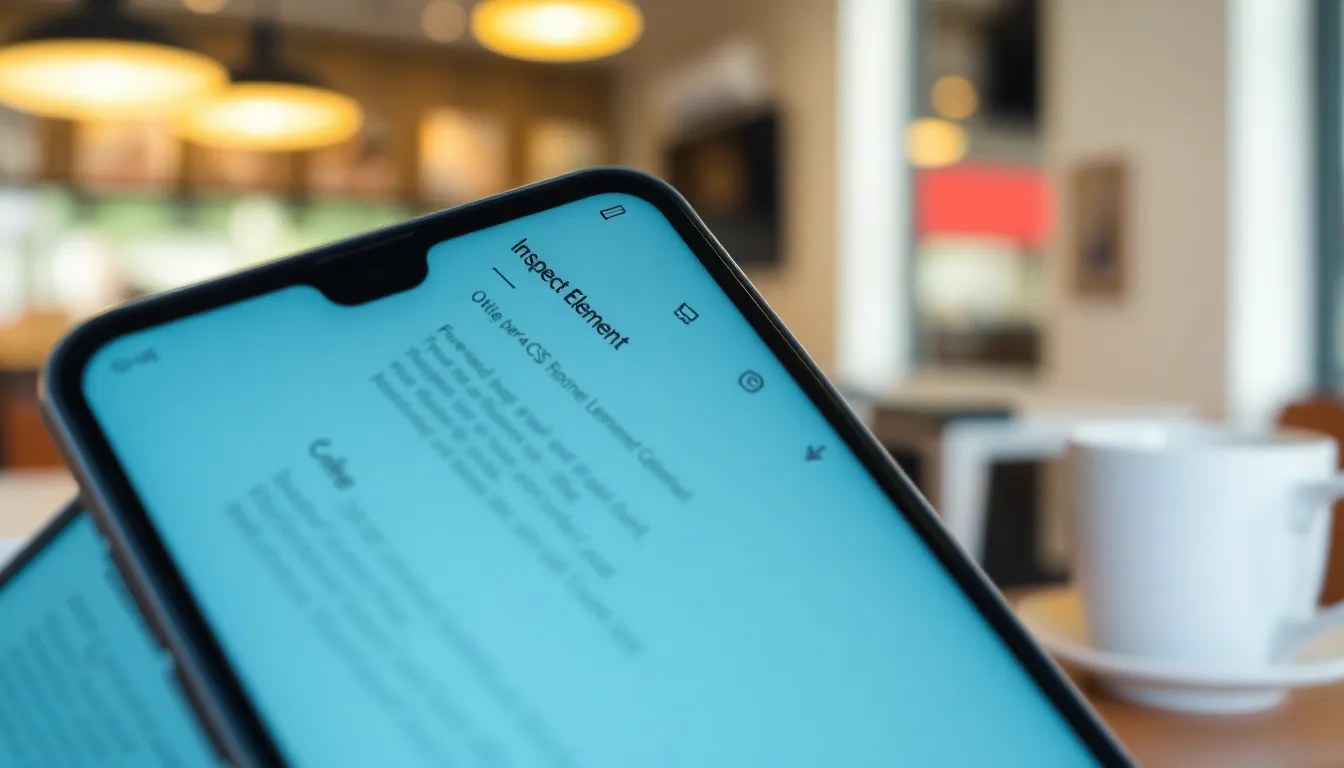Ever found yourself staring at a website on your Android device, wondering how they pulled off that sleek design? You’re not alone. Inspecting elements on Chrome for Android isn’t just for tech wizards anymore; it’s for anyone who wants to peek behind the digital curtain. With just a few taps, users can unleash their inner web developer and discover the secrets that make their favorite sites tick.
Inspect Element Chrome Android
The Inspect Element feature in Chrome for Android provides users a powerful tool for examining website structures. This functionality unveils the HTML and CSS that shape a webpage’s design. Users access this feature easily, turning their mobile devices into mini web development tools.
Exploration begins by right-tapping an element on the screen, revealing options to inspect it. Elements can be examined in real-time, allowing for quick adjustments and immediate visual feedback. Developers commonly appreciate this ability when troubleshooting issues or optimizing user interfaces.
Complex websites can become less daunting. Viewing their building blocks aids in understanding design principles and coding practices. Users can even copy certain elements, such as text or images, directly from the inspect interface to use in their projects.
Web designers often leverage this feature to gather inspiration from established sites. Dissecting popular layouts fosters creativity and innovation in their own work. Competitor analysis also becomes seamless with Inspect Element, aiding in strategic enhancements.
The mobile version may not offer all capabilities available on desktops, yet it provides substantial functionality. While certain advanced features like JavaScript debugging remain absent, many users find the existing tools sufficient for their needs. Inspecting style elements or verifying mobile responsiveness empowers users to make informed decisions about design and functionality.
This feature democratizes web development, making it accessible to everyone, regardless of technical background. Learning to use Inspect Element builds confidence, providing insights into web development processes. Understanding how sites create visual appeal leads to greater appreciation and informed engagement with digital content.
How to Access Inspect Element on Chrome for Android

Accessing the Inspect Element feature in Chrome for Android enables users to explore website structures easily. This functionality serves as a gateway for developers and designers to analyze web pages with just a few taps.
Using Chrome’s Built-In Tools
Chrome for Android allows users to access built-in tools for inspecting elements. Users can initiate the inspection process by long-pressing on any element on a webpage. A context menu appears, presenting the option to “Inspect.” This opens a simplified view of the HTML and CSS related to the selected element. Users gain insights into mobile responsiveness and style properties, benefiting those looking to optimize their designs. Adjusting elements in real-time provides immediate feedback, making troubleshooting straightforward.
Third-Party Apps and Extensions
Various third-party applications and browser extensions enhance the Inspect Element experience on mobile devices. Users can download these apps, which often provide more comprehensive inspection capabilities. Tools like “Web Tools” or “Responsive Web Design Tester” streamline the process, offering additional features that may not be present in Chrome’s built-in options. These applications support more robust CSS editing and enhanced design previews. Users appreciate the ability to save their adjustments and review changes in a local environment, fostering a more efficient design workflow. Exploring these tools allows users to expand their digital toolset for web development.
Common Uses of Inspect Element on Android
Inspect Element in Chrome for Android provides valuable tools for users engaging with web pages. This feature supports several key functionalities, enhancing the web development experience.
Debugging Mobile Web Pages
Debugging mobile web pages becomes efficient with Inspect Element. Developers identify issues and errors quickly by examining the underlying code. It highlights errors in JavaScript and CSS that may disrupt functionality. Adjustments can be made on the fly, ensuring real-time testing of solutions. Observations on mobile-specific problems often lead to quicker resolutions, making the debugging process seamless.
Analyzing Layout and Styles
Analyzing layout and styles is simpler when using Inspect Element. Users can view how various elements interact visually, providing insights into design decisions. They examine CSS properties like margins, padding, and colors easily, enabling them to understand aesthetic implementations. Design adjustments can occur directly within the tool, which allows for immediate visual representation of changes. This analytical approach fosters informed design improvements and strengthens user interfaces.
Limitations of Using Inspect Element on Android
Inspect Element on Chrome for Android comes with several limitations compared to its desktop counterpart. First, users encounter a smaller display area, which makes it challenging to interact with elements and view extensive code. Accessibility of more advanced features found in desktop versions remains restricted.
Many elements may not respond accurately due to variations in responsive design. Users often notice discrepancies when inspecting layouts that adapt differently to mobile devices. Examining JavaScript issues poses a bigger challenge as debugging tools are limited in mobile environments.
Possibly, real-time editing options become limited, preventing users from making extensive adjustments directly within the interface. Saving changes also lacks a straightforward implementation compared to the desktop experience. Options for managing styles or creating new stylesheets are significantly reduced on mobile.
Third-party applications provide some enhancements, but without full integration, they may not cover all user needs. Features that allow for the testing of dynamic content, like animations or transitions, may not display as expected. Consequently, understanding complex interactions on the page can be difficult.
Testing for compatibility with various browsers feels incomplete when only limited tools are available. Users often rely on external devices for comprehensive analysis, especially for sites with intricate designs. While Inspect Element on Android empowers users, the restrictions create challenges that can hinder in-depth exploration and modification.
Best Practices for Effective Usage
Utilizing the Inspect Element feature in Chrome for Android effectively requires a strategic approach. Prioritize using the long-press gesture on elements, as this method opens the inspection view. Engage with the simplified HTML and CSS layout to familiarize oneself with key structures and styles.
Focus on inspecting different elements across various websites to gain diverse insights. Explore real-time adjustments to see immediate visual effects, which aids in understanding how changes impact overall design. Copying elements for projects can inspire creativity and facilitate the assembly of new ideas.
Taking advantage of third-party applications can enhance the inspect experience. Web Tools and Responsive Web Design Tester provide advanced functionalities like robust CSS editing. Such tools allow users to save changes locally, optimizing their workflows significantly.
Identifying common issues in mobile web pages becomes easier through effective usage of this feature. Debugging JavaScript and CSS errors can happen swiftly, saving valuable development time. Observing layout interactions visually improves one’s ability to make informed design enhancements.
Navigating the limitations of mobile inspections is essential. Smaller display areas can lead to difficulties when viewing large amounts of code. Staying aware of the disparities between mobile and desktop functionalities feels crucial.
Overreliance on mobile inspections may hinder in-depth analysis; thus, external devices can complement the experience. Aspiring developers should embrace the learning opportunities Inspect Element offers while recognizing its constraints.
Conclusion
Exploring the Inspect Element feature in Chrome for Android opens up a world of possibilities for users interested in web development. This tool not only demystifies website structures but also empowers users to experiment with design elements effortlessly.
While it has its limitations compared to desktop versions, the ability to make real-time adjustments and gain insights into HTML and CSS remains invaluable. By leveraging this feature alongside third-party applications, users can enhance their understanding and creativity in web design.
Ultimately, embracing the Inspect Element tool can significantly elevate one’s skills and confidence in navigating the digital landscape.



